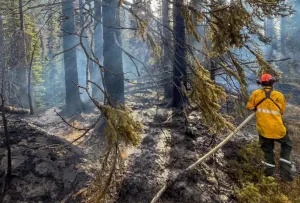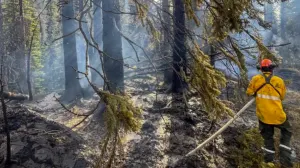
Saskatoon, Regina have seen record wildfire smoke so far in 2023
Visit The Weather Network's wildfire hub to keep up with the latest on the unprecedented wildfire season across Canada.
Saskatoon has been clouded by wildfire smoke so far this year more than any year in the previous four decades, while Regina has also experienced a record year, according to Environment and Climate Change Canada (ECCC).
Meteorologist Terri Lang said she expects more is on the way, as parts of B.C. and the Northwest Territories continue to burn, but it's hard to predict exactly how much.
"One way or another, [wildfire smoke is] going to be with us through the fall, so folks should be prepared for that — and prepared to modify their activities accordingly," Lang said.
Canada has experienced a record wildfire year. Flames from more than 6,100 wildfires have burned more than 16 million hectares so far, according to data from the Canadian Interagency Forest Fire Centre, a non-profit corporation owned and operated by federal, provincial and territorial wildfire fire management agencies.
The Saskatchewan Public Safety Agency has reported 424 total fires so far this year, as of 1:30 PM CST Tuesday.
MUST SEE: Best practices to keep yourself safe from wildfire smoke
Most of the country's wildfires have ignited in B.C. and Alberta, data shows. The Northwest Territories have the most active wildfires as of Tuesday, though.
As a consequence, smoke is drifting eastward due to prevailing winds in the northern hemisphere, Lang said.
ECCC tracks what it calls smoke hours, when smoke reduces visibility in an area to no more than 9.7 kilometres for a period of one hour.
As of midnight Tuesday, Saskatoon had experienced 282 smoke hours, shattering the previous record of 162 smoke hours the city experienced in 1981, according to the agency.
Regina, meanwhile, has so far experienced 221 smoke hours this year, breaking the record set in 2021 of 184 smoke hours.
SEE ALSO: As haze lingers, Edmonton and Calgary break records for summer smoke
Communities with a lot of smoke may experience an increase in hospital admissions while the smoke is there, said Scott Weichenthal, an associate professor of epidemiology, biostatistics and occupational health at McGill University in Montreal.
"The reason we worry about these kinds of events is not because the risk at the individual level is so great, but that the prevalence of exposure is very high," Weichental said. "When you have a small risk applied to a large number of people, it can be significant."
Less research is available regarding people who were exposed to smoke more often, he said, but one of the concerns is increased cancer rates over a period of years, because smoke contains known carcinogens.
Weichental noted that, while most of Canada views this wildfire season as extreme, the province of B.C. experiences significant wildfires every year.
Last year, Weichental and one of his PhD students were involved in a study that found, over years, people who lived closer to wildfires in B.C. had higher rates of lung cancer and brain tumours, he said.
The wildfire season typically extends through September, Lang said. This month is forecast to be warmer and drier than the seasonal average, so she expects wildfires will burn longer this year.
"The fires will likely keep going until the snow flies," Lang said.
As of noon CST Tuesday, the ECCC air quality health index suggests air quality is low risk in most of Saskatchewan, but the risk is expected to increase to moderate later Tuesday through Wednesday.
The weather agency has issued a special air quality statement for the southwest corner of Saskatchewan, in places like Swift Current, due to wildfire smoke.
Thumbnail courtesy of CBC News.
This article, written by Nicholas Frew, was originally published for CBC News.









